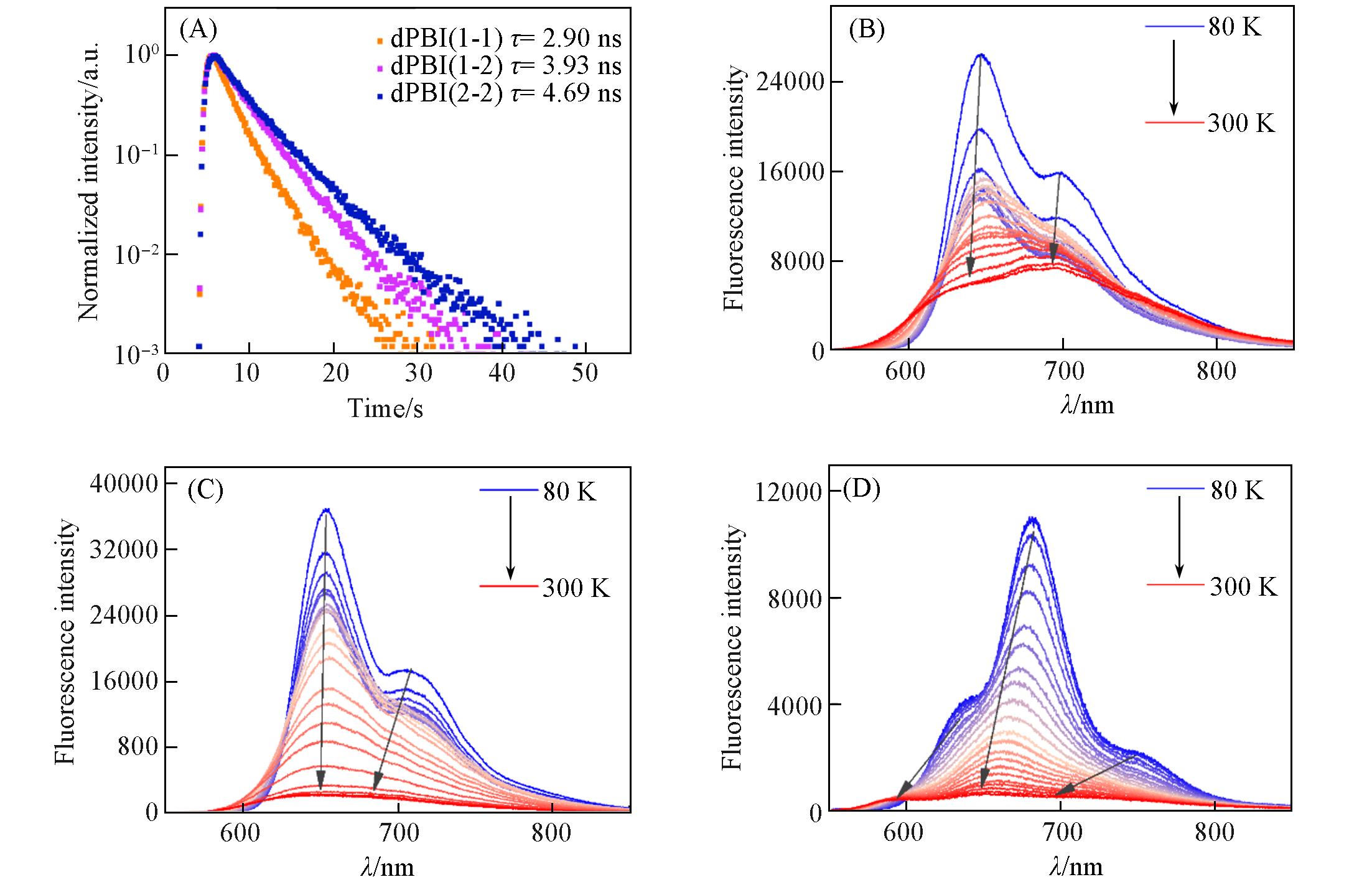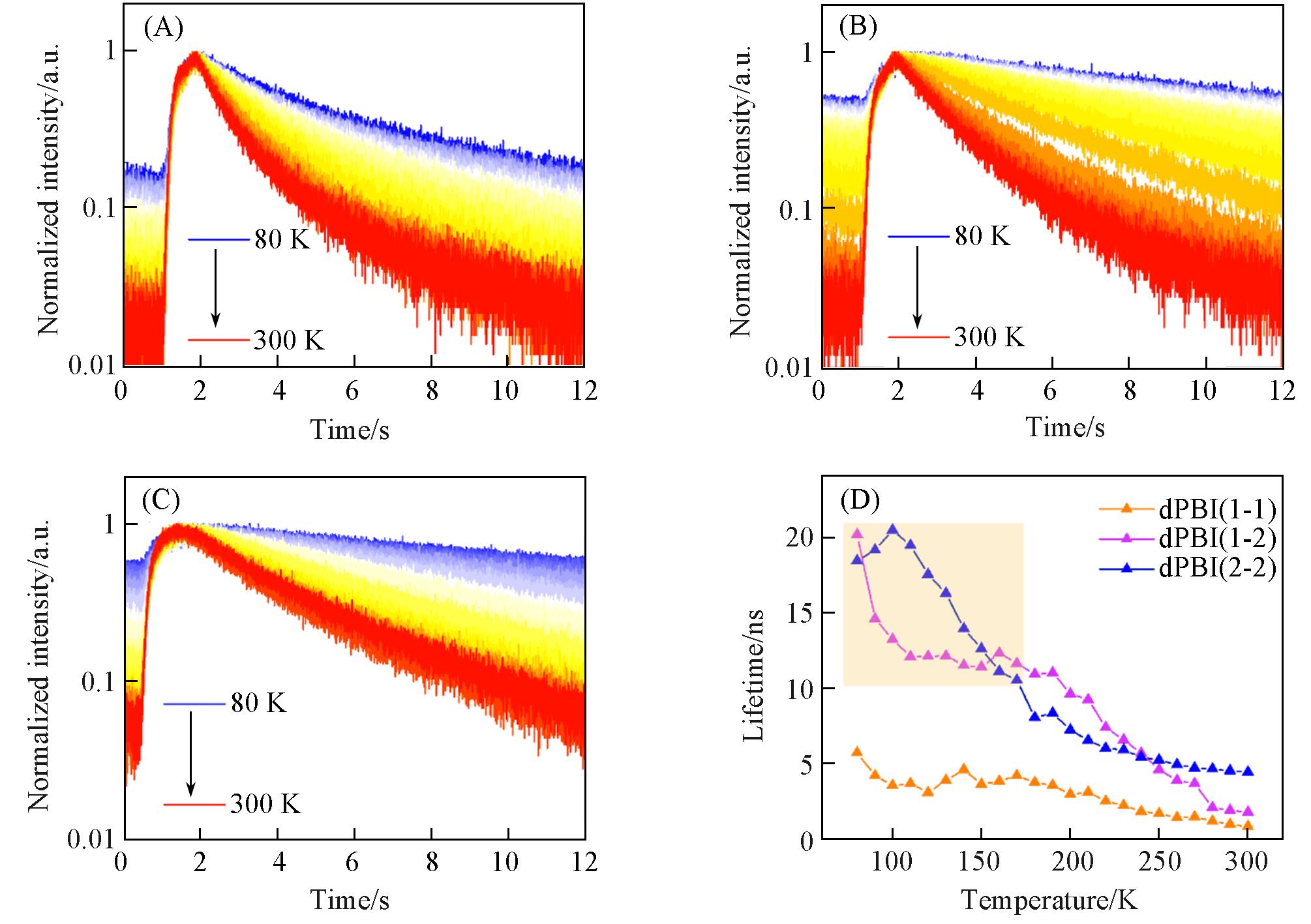

Chem. J. Chinese Universities ›› 2023, Vol. 44 ›› Issue (9): 20230092.doi: 10.7503/cjcu20230092
• Article • Previous Articles Next Articles
ZHANG Yu, CHEN Jiehuan, ZHOU Jiadong, LIU Linlin, XIE Zengqi( )
)
Received:2023-03-08
Online:2023-09-10
Published:2023-07-11
Contact:
XIE Zengqi
E-mail:msxiez@scut.edu.cn
Supported by:CLC Number:
TrendMD:
ZHANG Yu, CHEN Jiehuan, ZHOU Jiadong, LIU Linlin, XIE Zengqi. Aggregation Morphology of Perylene Bisimide Acceptors and the Role on Exciton Processes and Electron Transport in Organic Solar Cells[J]. Chem. J. Chinese Universities, 2023, 44(9): 20230092.

Fig.4 Fluorescence decays and temperature⁃dependent steady photoluminescence spectra of dPBIs(A) Fluorescence decays(λex=470 nm, λem=630 nm) of dPBIs as thin films; (B)—(D) temperature-dependent steady photoluminescence spectra of dPBI(1-1) film(B), dPBI(1-2) film(C) and crystalline dPBI(2-2)(D).
| Sample | λ | λ | ΦPL(%) | τFLa /ns | ||
|---|---|---|---|---|---|---|
| TOL b | DCM b | Film c | ||||
| dPBI(1⁃1) | 544 | 624 | 82.3 | 83.7 | 17.3 | 2.90 |
| dPBI(1⁃2) | 548 | 629 | 82.5 | 84.2 | 19.1 | 3.93 |
| dPBI(2⁃2) | 561 | 635 | 83.3 | 85.2 | 19.1 | 4.69 |
Table 1 Photophysical properties of dPBIs
| Sample | λ | λ | ΦPL(%) | τFLa /ns | ||
|---|---|---|---|---|---|---|
| TOL b | DCM b | Film c | ||||
| dPBI(1⁃1) | 544 | 624 | 82.3 | 83.7 | 17.3 | 2.90 |
| dPBI(1⁃2) | 548 | 629 | 82.5 | 84.2 | 19.1 | 3.93 |
| dPBI(2⁃2) | 561 | 635 | 83.3 | 85.2 | 19.1 | 4.69 |

Fig.5 Temperature⁃dependent photoluminescence decays of dPBIs(A)—(C) Temperature-dependent photoluminescence decay curves of dPBI(1-1), dPBI(1-2), and dPBI(2-2) using TCSPC module, respectively; (D) fitted photoluminescence lifetimes of dPBIs under different temperatures.
| Active layer | VOC/V | JSC/(mA·cm-2) | FF(%) | PCE(%) |
|---|---|---|---|---|
| PM6∶dPBI(1⁃1) | 0.93 | 10.13 | 68.79 | 6.48 |
| PM6∶dPBI(1⁃2) | 0.92 | 9.57 | 68.55 | 6.03 |
| PM6∶dPBI(2⁃2) | 0.92 | 4.36 | 61.51 | 2.47 |
Table 2 Summary of photovoltaic performance of PM6∶dPBIs-based OSCs under the illumination of AM 1.5G, 100 mW/cm2
| Active layer | VOC/V | JSC/(mA·cm-2) | FF(%) | PCE(%) |
|---|---|---|---|---|
| PM6∶dPBI(1⁃1) | 0.93 | 10.13 | 68.79 | 6.48 |
| PM6∶dPBI(1⁃2) | 0.92 | 9.57 | 68.55 | 6.03 |
| PM6∶dPBI(2⁃2) | 0.92 | 4.36 | 61.51 | 2.47 |
| 1 | Nowak⁃Król A., Shoyama K., Stolte M., Würthner F., Chem. Commun., 2018, 54(98), 13763—13772 |
| 2 | Zhan X., Facchetti A., Barlow S., Marks T. J., Ratner M. A., Wasielewski M. R., Marder S. R., Adv. Mater., 2011, 23(2), 268—284 |
| 3 | Würthner F., Saha⁃Möller C. R., Fimmel B., Ogi S., Leowanawat P., Schmidt D., Chem. Rev., 2016, 116(3), 962—1052 |
| 4 | Schaack C., Evans A. M., Ng F., Steigerwald M. L., Nuckolls C., J. Am. Chem. Soc., 2022, 144(1), 42—51 |
| 5 | Zhang M., Bai Y., Sun C., Xue L., Wang H., Zhang Z. G., Sci. China Chem., 2022, 65(3), 462—485 |
| 6 | Ding K., Shan T., Xu J., Li M., Wang Y., Zhang Y., Xie Z., Ma Z., Liu F., Zhong H., Chem. Commun., 2020, 56(77), 11433—11436 |
| 7 | Deng M., Zhang G., Yu L., Xu X., Peng Q., Chem. Eng. J., 2021, 426, 131910 |
| 8 | Wen X., Nowak⁃Król A., Nagler O., Kraus F., Zhu N., Zheng N., Müller M., Schmidt D., Xie Z., Würthner F., Angew. Chem. Int. Ed., 2019, 58(37), 13051—13055 |
| 9 | Yao J., Qiu B., Zhang Z. G., Xue L., Wang R., Zhang C., Chen S., Zhou Q., Sun C., Yang C., Xiao M., Meng L., Li Y., Nat. Commun., 2020, 11(1), 2726 |
| 10 | Wen X., Zhang Y., Xie G., Rausch R., Tang N., Zheng N., Liu L., Würthner F., Xie Z., Adv. Funct. Mater., 2022, 32(17), 2111706 |
| 11 | Yao J., Ding S., Zhang R., Bai Y., Zhou Q., Meng L., Solano E., Steele J. A., Roeffaers M. B. J., Gao F., Zhang Z. G., Li Y., Adv. Mater., 2022, 34(32), 2203690 |
| 12 | Rajaram S., Shivanna R., Kandappa S. K., Narayan K. S., J. Phys. Chem. Lett., 2012, 3(17), 2405—2408 |
| 13 | Zheng J. M., Wen X. B., Zhou J. D., Zheng N., Xie Z. Q., Acta Polym. Sin., 2019, 50(8), 775—807 |
| 郑介明, 文新博, 周家东, 郑楠, 解增旗. 高分子学报, 2019, 50(8), 775—807 | |
| 14 | Lin H., Chen S., Hu H., Zhang L., Ma T., Lai J. Y. L., Li Z., Qin A., Huang X., Tang B., Yan H., Adv. Mater., 2016, 28(38), 8546—8551 |
| 15 | Zhang G., Feng J., Xu X., Ma W., Li Y., Peng Q., Adv. Funct. Mater., 2019, 29(50), 1906587 |
| 16 | Russell J. C., Posey V. A., Gray J., May R., Reed D. A., Zhang H., Marbella L. E., Steigerwald M. L., Yang Y., Roy X., Nuckolls C., Peurifoy S. R., Nat. Mater., 2021, 20(8), 1136—1141 |
| 17 | Pedersen V. B. R., Pedersen S. K., Jin Z., Kofod N., Laursen B. W., Baryshnikov G. V., Nuckolls C., Pittelkow M., Angew. Chemie, 2022, 134(48), e202212293 |
| 18 | Cao J., Yang S., RSC Adv., 2022, 12(12), 6966—6973 |
| 19 | Fink R. F., Seibt J., Engel V., Renz M., Kaupp M., Lochbrunner S., Zhao H. M., Pfister J., Würthner F., Engels B., J. Am. Chem. Soc., 2008, 130(39), 12858—12859 |
| 20 | Hestand N. J., Spano F. C., Chem. Rev., 2018, 118(15), 7069—7163 |
| 21 | Bialas D., Kirchner E., Röhr M. I. S., Würthner F., J. Am. Chem. Soc., 2021, 143(12), 4500—4518 |
| 22 | Kasha M., Rawls H. R., El⁃Bayoumi M. A., Pure Appl. Chem., 1965, 11(3/4), 371—392 |
| 23 | Chen J., Tang N., Zhou J., Wang L., Jiang N., Zheng N., Liu L., Xie Z., J. Phys. Chem. Lett., 2021, 12(13), 3373—3378 |
| 24 | Wu C. H., Chueh C. C., Xi Y. Y., Zhong H. L., Gao G. P., Wang Z. H., Pozzo L. D., Wen T. C., Jen A. K. Y., Adv. Funct. Mater., 2015, 25(33), 5326—5332 |
| 25 | Ye L., Sun K., Jiang W., Zhang S., Zhao W., Yao H., Wang Z., Hou J., ACS Appl. Mater. Interfaces, 2015, 7(17), 9274—9280 |
| 26 | Nowak⁃Król A., Würthner F., Org. Chem. Front., 2019, 6(8), 1272—1318 |
| 27 | Pradhan R., Dahiya H., Bag B. P., Keshtov M. L., Singhal R., Sharma G. D., Mishra A., J. Mater. Chem. A, 2021, 9(3), 1563—1573 |
| 28 | Guo Q., Liu Y., Liu M., Zhang H., Qian X., Yang J., Wang J., Xue W., Zhao Q., Xu X., Ma W., Tang Z., Li Y., Bo Z., Adv. Mater., 2020, 32, 2003164 |
| 29 | Matthew Menke S., Holmes R. J., J. Mater. Chem. C, 2016, 4(16), 3437—3442 |
| 30 | Son M., Park K. H., Shao C., Würthner F., Kim D., J. Phys. Chem. Lett., 2014, 5(20), 3601—3607 |
| 31 | Kamma I., Kommidi P., Reddy B. R., Rev. Sci. Instrum., 2008, 79(9), 096104 |
| 32 | Lin J. D. A., Mikhnenko O. V., Chen J., Masri Z., Ruseckas A., Mikhailovsky A., Raab R. P., Liu J., Blom P. W. M., Loi M. A., García⁃Cervera C. J., Samuel I. D. W., Nguyen T. Q., Mater. Horizons, 2014, 1(2), 280—285 |
| 33 | Wakayama N., Williams D. F., Chem. Phys. Lett., 1971, 9(1), 45—47 |
| 34 | Wakayama N., Williams D. F., J. Chem. Phys., 1972, 57(4), 1770—1779 |
| 35 | Zhang M., Guo X., Ma W., Ade H., Hou J., Adv. Mater., 2015, 27(31), 4655—4660 |
| 36 | Mihailetchi V. D., Koster L. J. A., Hummelen J. C., Blom P. W. M., Phys. Rev. Lett., 2004, 93(21), 19—22 |
| 37 | Schilinsky P., Waldauf C., Brabec C. J., Appl. Phys. Lett., 2002, 81(20), 3885—3887 |
| 38 | Koster L. J. A., Mihailetchi V. D., Ramaker R., Blom P. W. M., Appl. Phys. Lett., 2005, 86(12), 123509 |
| [1] | WU Jifa, WU Hanping, YUAN Lin, PENG Xiaobin. Enhancing the Performances of Porphyrin-based All-small-molecule Ternary Organic Solar Cells via Synergizing Fullerene and Non-fullerene Acceptors [J]. Chem. J. Chinese Universities, 2023, 44(9): 20230136. |
| [2] | SONG Yanan, YOU Zuhao, WANG Xu, LIU Yao. Research Progress of Electroactive Ionene-based Organic Photovoltaic Interlayers [J]. Chem. J. Chinese Universities, 2023, 44(9): 20230167. |
| [3] | WANG Jiacheng, CAI Guilong, ZHANG Yajing, WANG Jiayu, LU Xinhui, ZHAN Xiaowei, CHEN Xingguo. Simple Modulation of Side-chains of Near-infrared Absorbing Non-fullerene Acceptor for Higher Short-circuit Current Density [J]. Chem. J. Chinese Universities, 2023, 44(9): 20230163. |
| [4] | ZHANG Lifu, WANG Xinkang, CHEN Yiwang. New Strategy to Balance the Miscibility and Phase Separation to Improve Organic Solar Cells Efficiency [J]. Chem. J. Chinese Universities, 2023, 44(9): 20230177. |
| [5] | WANG Jiarui, YU Runnan, TAN Zhan’ao. Recent Advances in the Application of Metal Complexes for Organic Solar Cells [J]. Chem. J. Chinese Universities, 2023, 44(9): 20230150. |
| [6] | TIAN Mei, ZHANG Zhiyang, ZHAN Chuanlang. Fused-benzotriazole Based p-Type Polymers: Fine-tuning on Absorption Band-width and Bandgap via Backbone Thiophene and Selenophene Strategies [J]. Chem. J. Chinese Universities, 2023, 44(9): 20230190. |
| [7] | LI Hao, YANG Chenyi, LI Jiayao, ZHANG Shaoqing, HOU Jianhui. Efficient Organic Solar Cells Based on Acceptor1-acceptor2 Type Polymer Donor [J]. Chem. J. Chinese Universities, 2023, 44(9): 20230157. |
| [8] | SHI Shiling, JIANG Hanxi, TU Xueyang, XIAN Kaihu, HAN Dexia, LI Yanru, YAO Xiang, YE Long, FEI Zhuping. Synthesis and Photovoltaic Properties of Non-fullerene Acceptors Based on Aryl-substituted Imide End Groups [J]. Chem. J. Chinese Universities, 2023, 44(9): 20230182. |
| [9] | GUO Ziqi, JIAO Cancan, WU Simin, MENG Lingxian, SUN Yanna, KE Xin, WAN Xiangjian, CHEN Yongsheng. Effect of Substitution Positions of Alkyl Chains in Small Molecular Donor Bridged Units on the Performance of Photovoltaic Devices [J]. Chem. J. Chinese Universities, 2023, 44(9): 20230180. |
| [10] | ZAFAR Saud uz, ZHANG Weichao, YANG Shuo, LI Shilin, ZHANG Yingyu, ZHANG Yuan, ZHANG Hong, ZHOU Huiqiong. Beta-alanine as a Dual Modification Additive in Organic Solar Cells [J]. Chem. J. Chinese Universities, 2023, 44(9): 20230185. |
| [11] | BAI Yuanqing, ZHANG Jiabin, LIU Chunchen, HU Zhicheng, ZHANG Kai, HUANG Fei. Alkyl Chain Engineering of Bithiophene Imide-based Polymer Donor for Organic Solar Cells [J]. Chem. J. Chinese Universities, 2023, 44(9): 20230271. |
| [12] | LI Yaokai, GUAN Shitao, ZUO Lijian, CHEN Hongzheng. Approaches to Achieving High-performance Semitransparent Organic Solar Cells [J]. Chem. J. Chinese Universities, 2023, 44(9): 20230166. |
| [13] | ZHENG Haolin, LIU Wuyue, ZHU Xiaozhang. Research Progress of Semitransparent Organic Solar Cells [J]. Chem. J. Chinese Universities, 2023, 44(9): 20230365. |
| [14] | LI Wei, CHEN Chen, LIU Dan, WANG Tao. Hierarchical Aggregates of Non-fullerene Electron Acceptors [J]. Chem. J. Chinese Universities, 2023, 44(9): 20230160. |
| [15] | MA Yifan, ZHANG Yamin, GAN Shengmin, ZHANG Yuchen, FEI Xian, WANG Ting, ZHANG Zeqi, GONG Xuezhu, ZHANG Haoli. Ternary Organic Photovoltaic Devices Based on Wide-band Gap Small Molecule Donor Third Component [J]. Chem. J. Chinese Universities, 2023, 44(9): 20230170. |
| Viewed | ||||||
|
Full text |
|
|||||
|
Abstract |
|
|||||